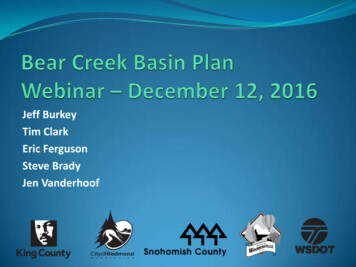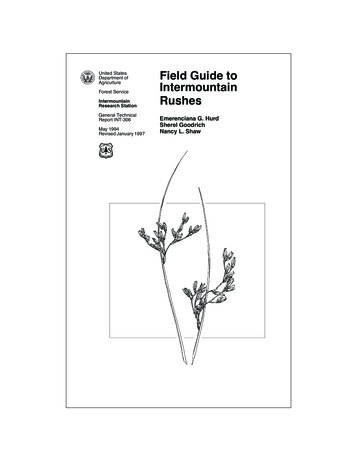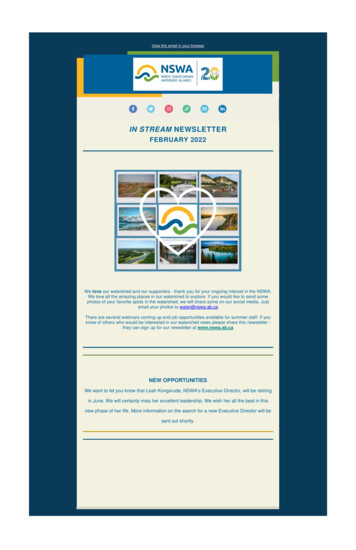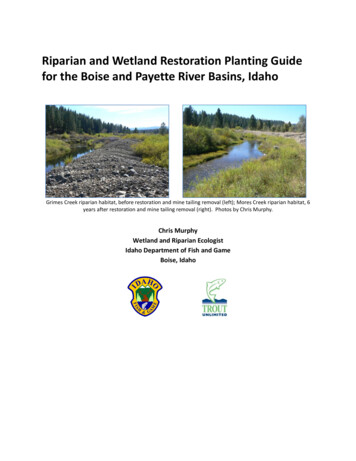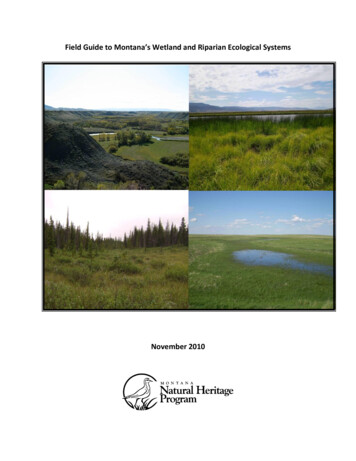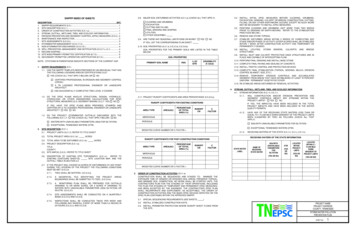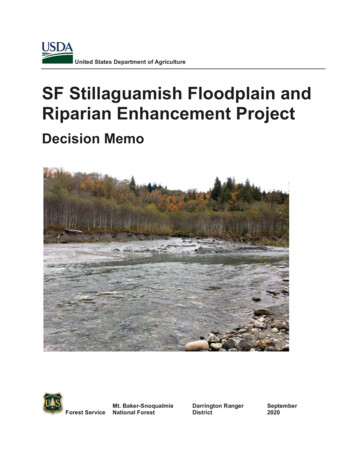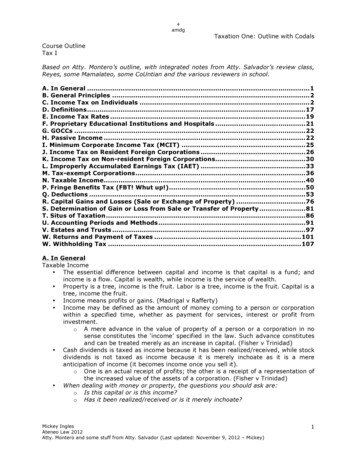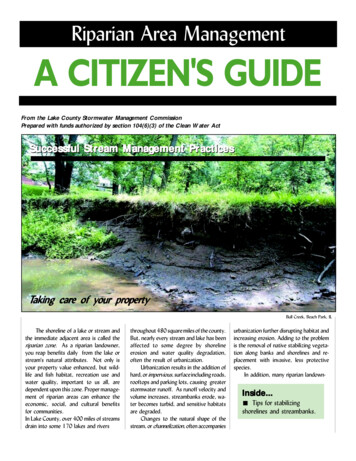
Transcription
Riparian Area ManagementA CITIZEN'S GUIDEFrom the Lake County Stormwater Management CommissionPrepared with funds authorized by section 104(6)(3) of the Clean Water ActSuccessful Stream Management PracticesStreamTaking care of your propertyBull Creek, Beach Park, ILThe shoreline of a lake or stream andthe immediate adjacent area is called theriparian zone. As a riparian landowner,you reap benefits daily from the lake orstream's natural attributes. Not only isyour property value enhanced, but wildlife and fish habitat, recreation use andwater quality, important to us all, aredependent upon this zone. Proper management of riparian areas can enhance theeconomic, social, and cultural benefitsfor communities.In Lake County, over 400 miles of streamsdrain into some 170 lakes and riversthroughout 480 square miles of the county.But, nearly every stream and lake has beenaffected to some degree by shorelineerosion and water quality degradation,often the result of urbanization.Urbanization results in the addition ofhard, or impervious, surface including roads,rooftops and parking lots, causing greaterstormwater runoff. As runoff velocity andvolume increases, streambanks erode, water becomes turbid, and sensitive habitatsare degraded.Changes to the natural shape of thestream, or channelization, often accompaniesurbanization further disrupting habitat andincreasing erosion. Adding to the problemis the removal of native stabilizing vegetation along banks and shorelines and replacement with invasive, less protectivespecies.In addition, many riparian landown-Inside.Inside. Tips for stabilizingshorelines and streambanks.
Successful stream managementers owners are not aware that inappropriate landscaping, improper disposal of lawnmaterials, and uncontrolled burning anddumping can cause erosion and poorwater quality, too.The results are sedimentation in streamsand lakes which degrades water quality;downcutting and widening stream bedsthat displace fish habitat; loss of shorelineand streambank property; and destabilization of structures such as bridges, piers,and foundations.There are useful, easy steps riparianContinued from page 1landowners can take to combat some of theeffects of urbanization. Preservation andconservation of streambanks, shorelines,and water quality rely on two principles: Informing riparian homeowners onthe causes and affects of soil erosionand poor water quality. Utilizing "Best ManagementPractices" (BMPs) for effective streamand watershed management.A restored streambank along Buffalo Creek. Vegetationmats on the banks will fill in.The components of riparian management1 More is not betterbetter.One of the largest problems for LakeCounty streams and lakes is highamounts of nutrients which produceexcessive growth of algae and otheraquatic plants. Nutrients can comefrom different sources but mostly fromthe overuse and misapplication of lawnfertilizers. TIPS: Follow directions. More is notbetter. Base fertilizer type andapplication rates on a soil test. Do not fertilize plants nearstreambanks and lake shores. Avoid spillage and application onimpervious areas where they are readilywashed off. Do not dump excess fertilizer, oranything into storm sewers. Use a mulching lawn mower toreduce the need for fertilizer application.2 No dumping allowed.Streambank erosion can be worsenedby leaves, grass clippings, and otheryard refuse placed along streambanks.Existing vegetation and stabilizing rootsare killed. When combined with anincrease in runoff, the bank soilsbecome unstable and begin to erodeinto the water. Loss of land will eventuallyoccur as more of the bank erodes. Yardwaste washed into streams andlakes also causes water qualityproblems related to excessive nutrientand organic loadings. TIPS: Properly dispose of yard refuse.Check with your municipality regardand pickup. Do not burn yard refuse on ornear the streambank. It pollutes thewater and destroys stabilizingvegetation. Encourage your community or Association to adopt an anti-dumpingordinance if they don't already haveone. Try composting, it's easy and youcan find out more about it by calling theSolid Waste Agency of Lake County(see page 6 for SWALCO information).2 Stockpile firewood and other materials away from the streambank. Logs andfloatable materials contribute to debrisjams and possible flooding.3 Excess debris spellsdisasterdisaster.Healthy streams provide effective stormwater conveyance and fish habitat. Oftenhowever, debris blockages occur, reducing channel capacity to convey watercausing elevated flood stages, and reduced aeration of the water. Debris canalso deflect streamflows into banks causing increased erosion. TIPS: "Urban artifacts" such as tires and oldequipment should be removed imme-diately. Routinely check stream channels forfallen branches, limbs and other debris.While natural accumulations of woody debris are good for habitat, excessive amountsof urban debris should be removed to avoidstream blockages.
4 Plant Some Roots.When ground and banks are left bare, soilwashes off into nearby streams. An eroding bank makes it difficult to supportvegetation and doesn't buffer other pollutants from entering the stream. TIPS: Establish vegetation on all bareareas. Temporarily stabilize with mulch orgeotextile fabric for protection tominimize erosion. Preserve a "buffer strip" of at least 10feet of dense, preferably natural vegetation to grow along the water's edge andstreambank. This allows pollutants to filterout and the bank to stabilize. Plant vegetation native to the Midwest for best results (see plant listing). Native vegetation, both woody andprairie species, is naturally deep-rootedand able to stabilize sensitive slopes. Many "natural" appearing banks arein trouble because invasive plants like buckthorn don't provide effective stabilizationand readily shed limbs contributing todebris jams. Invasive plants should be removedand replaced by native vegetation. Never mow to the edge of a streambank or shoreline. Leave a buffer of atleast several feet for root development.As indicated, native vegetation buffersare preferred. Never cut bluegrass shorter than 2.5"in height. The height allows larger anddeeper root systems making stronger defense against weeds and droughts.6 Tune into your channels.Natural meandering channels are often modified to improve drainage. Straightening,artificial lining, and dredging are some ofthe modifying practices. But channelizationresults in the removal of natural bufferstrips and aquatic habitat zones, increaseddownstream flooding and erosion, and increased sediments loads. TIPS:6 Manage land use along the entirelength of a stream. Minimize or avoid channel reshapingand straightening. Before any modifica-tions, consult your municipality or theLake County Stormwater ManagementCommission. Incorporate natural physical structures in the channel design to improvehabitat. Techniques could includepools, meanders, and native vegetation; for more severe erosion problems,lunkers and a-jacks. "Hard" erosionpractices such as rip rap,concrete rubble, gabion baskets, logsand seawalls are rarely appropriateand usually cause more erosion. Implement bank stabilizing measures. Native plantings, maintenance,and no dumping practices can secureyour bank or shoreline. Follow the Lake Co. WatershedDevelopment Ordinance and companion Technical Reference Manual forregulations and Best ManagementPractices for channel preservation andconstruction. Stabilize tiles and storm sewer outletsor other sources of concentrated flowsinto streams. Contact NRCS regarding removal ofinappropriate vegetation and planting ofdesirable species.5 Short grass doesn'tcut it.Short grass may look nice but doesn't havea deep root system and is ineffective as apollutant filter or wildlife habitat. TIPS: Consider native grasses rather thanKentucky bluegrass (see "Native Plants").Underneath the lawn clippings is an exposed streambank. Invasive plants like the buckthorn shrub (to the right of thepicture) and reed canary grass (in the water) offer no stabilizing roots to form. These invasive plants should be removedand replaced with native vegetation. And of course, no dumping!3
Alternative bank stabilizing methodsStreambank erosion generally occursas a result of the action of streamflowagainst the toe (base) of an unprotectedslope. While placing stone rip-rap, railroadties, or concrete on an eroding streambank appears to solve the problem, thesepractices are often prone to failure as theydo not stabilize the toe properly.Another problem with "hard" solutionsis that they do not dissipate any of theexcess stream energy that was causingthe erosion problem; rather they transferand sometimes amplify this energy to thenext section of unprotected streambank,creating a new set of problems. Unlessthe entire stream is treated in this manner,a costly and unsightly option, the erosionproblem is not solved, only transferredand usually causing increased erosion.In contrast, the use of vegetation instabilizing streambanks is a proven lowcost, highly effective solution. Nativevegetation features extensive root systems which help bind the soil in thestreambanks. The top growth serves todeflect erosive stream flows away fromthe bank, while dissipating the energy ofthe stream. This reduces the potential forerosion problems to be transferred tonew locations.Bio-engineering techniques combine vegetation with structural practices. A-jacks (above) installed at the toe of thebank, and gabion baskets (below) installed on the slopesalso help to slow water down. Different situations requiredifferent techniques so consult a professional engineer forthe best solution to your erosion problem.Go native with prairie plantsConsider establishing native plant prairies in your backyard. Native plant communities often contain dozens or hundreds ofspecies. While many of the species are notcommonly available in the retail landscapemarket, specialized native plant nurseriesand landscapers can often obtain them.Also, check out soil and water conservationdistricts for annual tree, shrub and prairieplant sales, and suggested readings.The plants listed here represent onlya small portion of the native speciespotentially available for stream corridorlandscaping.However, as native plants often havemore specialized requirements tobecome established and thrive, it is importantthat the proper plant material beselected. Some factors to considerinclude the soils present, amount ofsunlight available, depth and velocity of streamflow during storm events, and competitionfrom non-native species. TIPS:Vegetation techniques typically involve conducting a minimum amount ofexposed area, and implementing appropriate erosion control practices until thevegetation becomes fully established.In areas where rapid streamflow occurs during rain events, a combination ofvegetative and structural solutions maybe more appropriate. A number of "biotechnical" practices are available, including Lunker Structures, A-Jack Structures,and Bio-Logs. In larger streams, thesepractices can also provide habitat formany types of fish.Because problems result from poorlydesigned and constructed projects, landowners should seek professional assistance in determining the cause of theirstreambank erosion problem, as well asidentifying possible alternatives and theneed for permits. Depending on thescope and location of the project,federal, state, or local permits maybe required.For more on bio-engineering practices, see the "Streambank and Shoreline Protection Manual" available todownload at www.co.lake.il.us/smc/publications. Avoid seeding of native grassesor wildflowers in stream corridors asthe seed can be washed away duringhigh flows. Instead, use rooted plantmaterial that can be firmly plantedinto the ground. Get a copy of NIPC's "Native PlantGuide" appropriate native plants fornortheastern Illinois. To order. call theLake County SWCD. Avoid canned wildflower mixes. They Call the Chicago Botanic Garden,often contain non-native species or a highpercentage of annuals that provide nolong term stabilization benefits.a local garden club, forest preservedistrict, arboretum, conservation groupand others for information and courseson designing, installing, and maintainingnative landscapes.4
Desirable Plant Species Trees *Genus/speciesAcer rubrumQuercus bicolorQuercus macrocarpaTilia americanaPhoto by Illinois Nature Preserve CommissionCommon NameRed MapleSwamp White OakBur OakBasswoodShrubs *Common NameButtonbushRed-Osier DogwoodElderberryArrowwood ViburnumGenus/speciesCephalanthus occidentalisCornus stoloniferaSambucus canadensisViburnum dentatumBuck ThornPurple Loose StrifeCommon NameSweet FlagWater PlantainRiver BulrushArrowheadGenus/speciesAcorus calamusAlisma subcordatumScirpus fluviatusSagittaria latifoliaShoreline Flowers *Common NameBlue Flag IrisYellow ConeflowerBlack-Eyed SusanGenus/speciesIris virginicaRatibida pinnataRudbeckia hirtaShoreline Grasses *Common NameBig BluestemBluejoint GrassSwitch GrassPrairie Cord GrassGenus/speciesAndorpogon gerardiiCalamagrostis canadensisPanicum virgatumSpartina pectinata*Many more desirables exist.Photo by Kenneth R. Roberts, INHSEmergent Wetland Plants *Box ElderPhotos by W.L. Wagner,NPDC@PLANTSGarlic MustardUndesirable Plant SpeciesCommon NameBox ElderGarlic MustardTartarian HoneysuckleReed Canary GrassCommon BuckthornGlossy BuckthornMultiflora RosePurple LoosestrifeGenus/speciesAcer negundoAllilaria officinalisLonicera tataricaPhalaris arundinaceaRhamnus catharticaRhamnus frangulaShrubRosa multifloraLythrum SalicaraiGrowth FormTreeGroundcoverShrubGrassShrubShrubPlantRain Gardens and Rain BarrelsIllinoisPlanningCommissionDeep Root Systems Can Stabilize Banks and ShoresNortheasternRain gardens are just what they soundlike - gardens that soak up rain water,mainly from your roof, but also fromyour driveway and lawn. They arelandscaped areas planted to wildflowers and other native vegetation toreplace areas of lawn. The gardens fillwith a few inches of water and allowthe water to slowly filter into theground rather than running off tostorm drains. Compared to a patch ofconventional lawn, a rain gardenallows about 30 percent more waterto soak into the ground. Try rainbarrels, too, to filter rain water and towater your plants.5Rev. 11/02
Where to go for more informationStream/shoreline BestManagement PracticesWetlands, habitat,endangered speciesLake Co. Stormwater ManagementCommission (SMC)333-B Peterson RoadLibertyville, IL 60048(847) 918-5260www.co.lake.il.us/smcU.S. Fish and Wildlife Service1250 S. Grove, Ste 103Barrington, IL 60010(847) 381-2253www.fws.govNortheastern Illinois PlanningCommission (NIPC)222 S. Riverside Plaza, Ste 1800Chicago, IL 60606(312) 454-0400www.nipc.cog.il.orgLake Co. Soil and WaterConservation District (SWCD)100 N. Atkinson Road, Ste 102-AGrayslake, IL 60031(847) 223-1056www.lakeswcd.orgBank stabilizing methods,bioengineering techniquesNIPC, SWCD, SMCChannel modificationmethods, permitsYour municipality, SMCLakes management,pollutants, water qualityLake Co. Health DepartmentLakes Management Unit3010 Grand AvenueWaukegan, IL 60085(847) 360-6747www.co.lake.il.us/ehs/lakesSoil erosion, plant species,pesticides/fertilizer usesSWCD, Lakes Management UnitNative Plant InformationNIPC's Native Plant Guide availablefor purchase at SWCD or seewww.nipc.cog.il.orgVolo Bog State Natural Area28478 W. Brandenburg RoadIngleside, IL 60041(815) arks/R2/VOLOBOG.HTMIllinois Department of Natural Resources,Div. of Water Resources(217) 782-0690http://dnr.state.il.us/Lakes Management UnitSWCD, SMCTo report stream pollutionIllinois Environmental ProtectionAgency Emergency Response Unit(312) 531-5900 or (217) 782-3637www.epa.state.il.us/To report wetland violationsSMC,U.S. Army Corps of Engineers Regulatory Branch(312) 353-8213www.lrc.usace.army.mil/Composting, yard wastedisposalYour municipality,Solid Waste Agency of Lake County(SWALCO)111 N. EstesGurnee, IL 60031(847) 336-9340www.swalco.orgAdditional web links are on SMC's website.Other household guidelines Recycle used motor oil. Do not pouron the ground, in a stream or down astormdrain. Stormdrains flow intonearby streams and lakes, contaminatingwater and sediments, and creating oilslicks. Rather, put your oil in a plasticcontainer and take to the nearest oilrecycling center (gas stations). Direct roof downspouts to grassedareas, not to driveways or other surfacesthat don't allow the water to soak in.Install a rain garden or a rain barrel tocapture runoff and pollutants. For more onrain gardens, see University of WisconsinExtension's brochure, "Rain Gardens A Household Way to ImproveWater Quality in Your Community."Call(877) 947-7827 for a brochure. Use small amounts of low-phosphorous detergents to wash your car to re-6duce the amount of phosphorus gettingto the stream or lake. Wash the sudsinto the grass not down your driveway. Limit your use of pesticides, fertilizers, and other substances that haveserious impacts on aquatic life if discharged into streams or lakes. To dispose of latex paint, let the can dry out,then scrape what's left into the garbage.For unused oil-based paints and othersolvents, pesticides, fertilizers, and spraycans, watch for local "household hazardous waste days" in your communityor call SWALCO. Maintain septic tank systems properly. Regular inspections and licensedpumping should be done every two tothree years. Call the Health Departmentfor more on septic tank maintenance.
Successful Stream Management Practices A CITIZEN'S GUIDE From the Lake County Stormwater Management Commission Prepared with funds authorized by section 104(6)(3) of the Clean Water Act Riparian Area Management throughout 480 square miles of the county. But, nearly every stream and la

